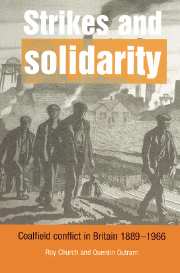Book contents
- Frontmatter
- Contents
- List of figures and tables
- Preface
- List of abbreviations
- 1 Interpreting coalfield conflict: focus and formulations
- 2 Tradition and modernity: the mining industry 1889–1940
- 3 Employers and workers: organizations and strategies
- 4 Employers and workers: ideologies, attitudes and political orientations
- 5 Configurations of strike activity
- 6 Strike participation and solidarity before 1912
- 7 Strikes, organization and consciousness in 1912 and after
- 8 Conflictual context? The ‘isolated mass’ revisited
- 9 Mining and modernity: size, sectionalism and solidarity
- 10 The foundations of strike propensity
- 11 Miners and management: agency and action
- 12 Industrial relations and strikes after nationalization
- 13 International perspectives
- 14 Myths and realities: strikes, solidarity and ‘militant miners’
- General appendix
- List of references
- Index
5 - Configurations of strike activity
Published online by Cambridge University Press: 04 December 2009
- Frontmatter
- Contents
- List of figures and tables
- Preface
- List of abbreviations
- 1 Interpreting coalfield conflict: focus and formulations
- 2 Tradition and modernity: the mining industry 1889–1940
- 3 Employers and workers: organizations and strategies
- 4 Employers and workers: ideologies, attitudes and political orientations
- 5 Configurations of strike activity
- 6 Strike participation and solidarity before 1912
- 7 Strikes, organization and consciousness in 1912 and after
- 8 Conflictual context? The ‘isolated mass’ revisited
- 9 Mining and modernity: size, sectionalism and solidarity
- 10 The foundations of strike propensity
- 11 Miners and management: agency and action
- 12 Industrial relations and strikes after nationalization
- 13 International perspectives
- 14 Myths and realities: strikes, solidarity and ‘militant miners’
- General appendix
- List of references
- Index
Summary
From Nine Mile Point to Bothwell Castle: dimensions, concentration and prevalence of coalmining strikes
The development of the industry, the evolution of coalowners' associations and miners' trade unions, and the changing institutions and character of industrial relations have been the subject of chapters 2, 3 and 4. While in later chapters we shall refer back to those aspects which have a particular relevance to the history of strikes in the industry, we here consider the statistical evidence on strike activity which we have assembled from the archival sources introduced in chapter 1. In this chapter we consider important issues which historians and other scholars have explored either within a very partial, chronological or spatial context, or by using aggregate statistics, or by focusing exclusively on national strikes. The key questions which require consideration are whether the industry's reputation for being uniformly strike-prone is consistent with the evidence, and whether solidarity among miners was a prevailing feature of strikes at district and local levels. There are two justifications for focusing on district and local levels. The first is that the overwhelming proportion of strikes which occurred were limited to localities; they represented, therefore, the ‘ordinary’ characteristics of mining strikes and the ‘normal’ experience of miners and colliery owners in conflict. The second is that we know that in modern manufacturing strikes are far from being a widespread experience: they are concentrated in a small number of highly strike-prone plants (Department of Employment, Strikes in Britain). We need to see whether strikes have been similarly concentrated in British collieries or whether coalmining is indeed a ‘special case’ (Turner 1963: 7), with a high propensity to strike widely distributed across the generality of collieries.
- Type
- Chapter
- Information
- Strikes and SolidarityCoalfield Conflict in Britain, 1889–1966, pp. 74 - 94Publisher: Cambridge University PressPrint publication year: 1998



